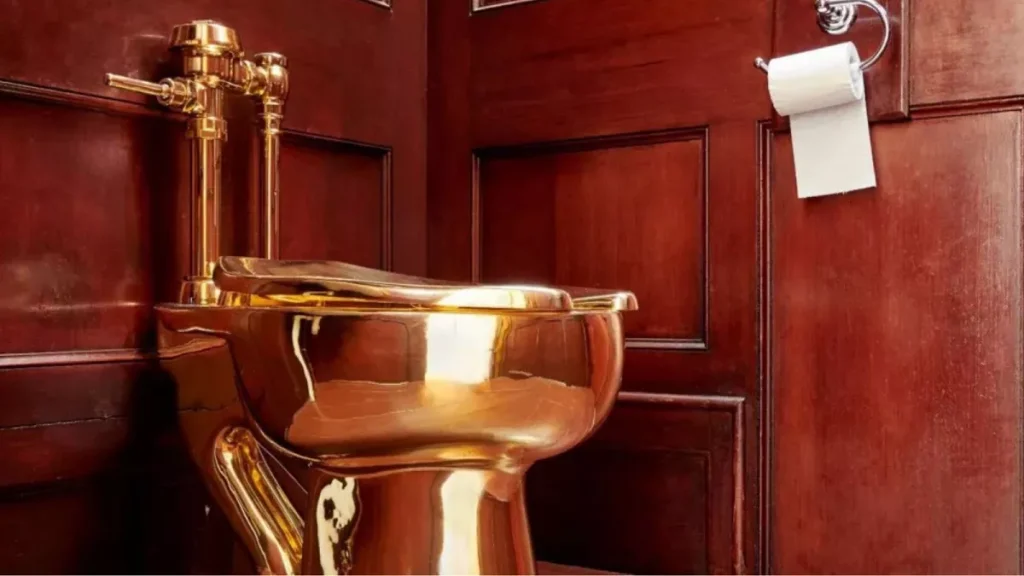
A man has been convicted for his role in the audacious theft of an 18-carat gold toilet from Blenheim Palace, the birthplace of Winston Churchill. The lavish artwork, valued at approximately £4.8 million (around $6 million), was stolen in a carefully executed heist in September 2019. The golden toilet, an interactive art piece titled America, was designed by Italian artist Maurizio Cattelan and intended as a satirical commentary on wealth and excess.
The Theft at Blenheim Palace
In the early hours of September 14, 2019, a group of thieves broke into Blenheim Palace, a UNESCO World Heritage Site in Oxfordshire, England. The criminals used two stolen vehicles to ram through the palace gates before making their way to the restroom where America was installed. The thieves swiftly removed the toilet using sledgehammers and crowbars, causing severe damage to the building’s plumbing system and flooding parts of the historic property.
The entire heist lasted less than five minutes, with the perpetrators fleeing the scene before security could intervene. Despite an extensive police investigation, the golden toilet was never recovered, and authorities believe it was melted down or broken into smaller pieces to facilitate its sale.
Convictions and Sentencing
Following years of investigation, multiple individuals have been convicted in connection with the heist:
- Michael Jones (39): Convicted of burglary for his role in planning and executing the theft.
- James Sheen (40): Identified as the mastermind behind the heist, Sheen pleaded guilty to burglary, conspiracy to transfer criminal property, and transferring criminal property.
- Frederick Doe (36): Found guilty of conspiracy to transfer criminal property for his involvement in selling the stolen gold.
- Bora Guccuk (41): Acquitted of conspiracy to transfer criminal property.
Jones and Sheen face significant prison sentences, while sentencing for Doe is expected in the coming weeks. Authorities are still attempting to trace the stolen gold and any remaining proceeds from the crime.
Artistic and Financial Impact
The theft of America not only resulted in a major financial loss but also sparked international outrage. The golden toilet, originally displayed at the Guggenheim Museum in New York before being installed at Blenheim Palace, was a thought-provoking piece designed to reflect economic disparity and modern consumerism.

With its disappearance, one of contemporary art’s most famous satirical works has been lost. Blenheim Palace, which frequently hosts high-profile art exhibitions, has since reinforced its security measures to prevent similar incidents in the future.
Investigation and Legal Proceedings
The Thames Valley Police spearheaded the investigation, utilizing CCTV footage, forensic evidence, and witness statements to track down the suspects. Despite several arrests in the months following the heist, bringing the case to trial took years due to the complexity of tracing the stolen gold and establishing the full extent of criminal involvement.
During the trial at Oxford Crown Court, prosecutors detailed how the gang meticulously planned the heist, using high-powered tools and stolen vehicles. The defense argued that some of the accused had minimal involvement, but the court ruled against their claims based on substantial evidence.
For more details on the judicial process and ongoing investigations into art theft, visit the UK Crown Prosecution Service: www.cps.gov.uk.
The Fate of the Golden Toilet
Despite the convictions, the ultimate fate of America remains a mystery. Experts believe the gold has been melted and sold through underground networks, making it nearly impossible to recover. Police continue to investigate potential leads related to the whereabouts of the stolen material, though hopes of retrieving the toilet in its original form are slim.
Art thefts, particularly those involving high-value pieces, often pose significant challenges for law enforcement. Authorities have urged individuals with any information regarding the stolen gold to come forward via the UK Metropolitan Police’s art crime division: www.met.police.uk.
Conclusion
The conviction of those responsible for the theft of America marks a significant step in resolving one of the most notorious art heists in recent history. However, the loss of the artwork is a stark reminder of the vulnerabilities faced by museums and heritage sites worldwide. As security measures continue to evolve, the incident at Blenheim Palace serves as a case study in both the risks and resilience of the art world.
For further updates on major theft investigations and legal proceedings in the UK, visit the official website of the UK Home Office: www.gov.uk.



